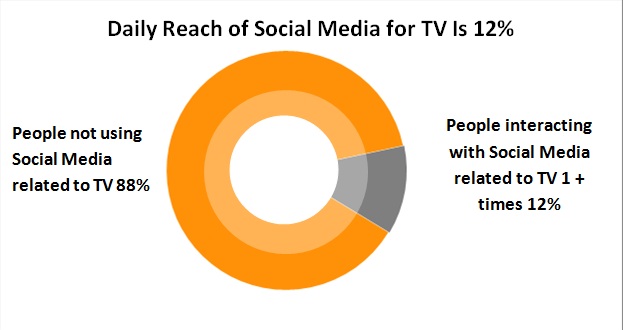“Social TV” is all the rage, or so it feels. An estimated 40% of Twitter traffic during the prime time period is about television, according to Wired Magazine’s recent “Platinum Age of Television” issue. “And that’s why, some day in the near future, a show’s tweetability may be just as crucial as the sheer size of its audience,” writes Wired.
But what role does social media really play in driving people’s viewing behavior? Is social TV “the real deal” as some argue, or is the industry making more of it than consumer behavior would suggest it should?
At the ARF’s recent Audience Measurement 8.0 conference, Beth Rockwood, SVP of Discovery Communications and Richard Zackon from the Council for Research Excellence (CRE) shared results from an ambitious research program that sheds new, important light on the topic. We at the Keller Fay Group were pleased to be part of the multi-pronged research team that produced the study, “Talking Social TV,” together with Nielsen’s Life360 and NM Incite units, and Bluefin Labs.
This research goes well beyond a simple survey asking people how much they engage in social media when it comes to TV. It also goes beyond tracking statistics about the number of posts on Twitter or Facebook, which are unable to provide context for understanding where social media fits relative to other influences that could lead people to watch shows.
This new research is based on a sample of more than 1700 consumers ages 18-54 who kept track of all their exposures to prime time television and the late local news for a one week period via the use of a diary that could be accessed via a mobile app. Any respondents who were not smartphone enabled were provided one so that they could participate. The 1700+ respondents provided data about more than 25,000 interactions they had with television programs, both while they were watching and at times when they were not watching. Among the contact points they reported to us were: social media (both posts they made and those they saw), talking offline to others about a show, reading an article or blog about a show, IM or texting about a show, seeing an ad or promo, etc. This methodology provides a rich, deep ability to understand social media in a way that has been heretofore looked at primarily in isolation from other factors.
How Many Use Social Media to Interact with TV?
Here is the key finding from the research: The belief that social media is ubiquitous, or nearly so, is unfounded, at least at present. When it comes to direct influence on their TV viewing, only 1.5% of respondents report being drawn to TV viewing occasions because of social media. But, it is important to note, that number increases to 6% when it comes to their decision to watch new shows.
Further, consumer interaction with social media in relation to their television viewing is relatively modest compared to other forms of communication, and lags behind other online media, TV promotions and, especially, offline communication. More specifically, only 12% of respondents use social media one or more times per day for content related to TV.

(Source: Keller Fay Group, “Talking Social TV: Understanding the
Effects of Social Media & Television Viewing” for the Council for Research Excellence, 2013.)
A greater number – 37% -- use social media at least once a week to engage with TV, suggesting growth potential for social media as an influence on TV viewing if these infrequent users become more frequent over time.
Among the other key findings from this study:
- Social media use varies by genre. Sci-Fi, Sports and Talk/News show strong interaction overall. Reality programming's interaction is much stronger while people are watching, less so before or after the program. Comedy follows the opposite pattern, with less interaction during the program and more interaction in reaction to the program.
- Hispanics are more involved with social media than the general population. While watching TV, Hispanics are 50% more likely to interact with social media related to television, and to interact with most television genres, led by sports programming.
- People who own mobile devices (smartphones and tablets) have higher social media interaction with TV.
The results from this extensive research were integrated with data from various other sources (such as Nielsen ratings data and data about TV promos), by an academic team who created a statistical model that looks further at the role of social media in driving television viewing. Those results will be discussed in my next post on this research.
Stay tuned.
Ed Keller, CEO of the Keller Fay Group, has been called "one of the most recognized names in
Read all Ed’s MediaBizBloggers commentaries at WOM Matters.
Check us out on Facebook at MediaBizBloggers.com
Follow our Twitter updates @MediaBizBlogger
The opinions and points of view expressed in this commentary are exclusively the views of the author and do not necessarily represent the views of MediaBizBloggers.com management or associated bloggers. MediaBizBloggers is an open thought leadership platform and readers may share their comments and opinions in response to all commentaries.
[Image courtesy of JanPietruszka/]